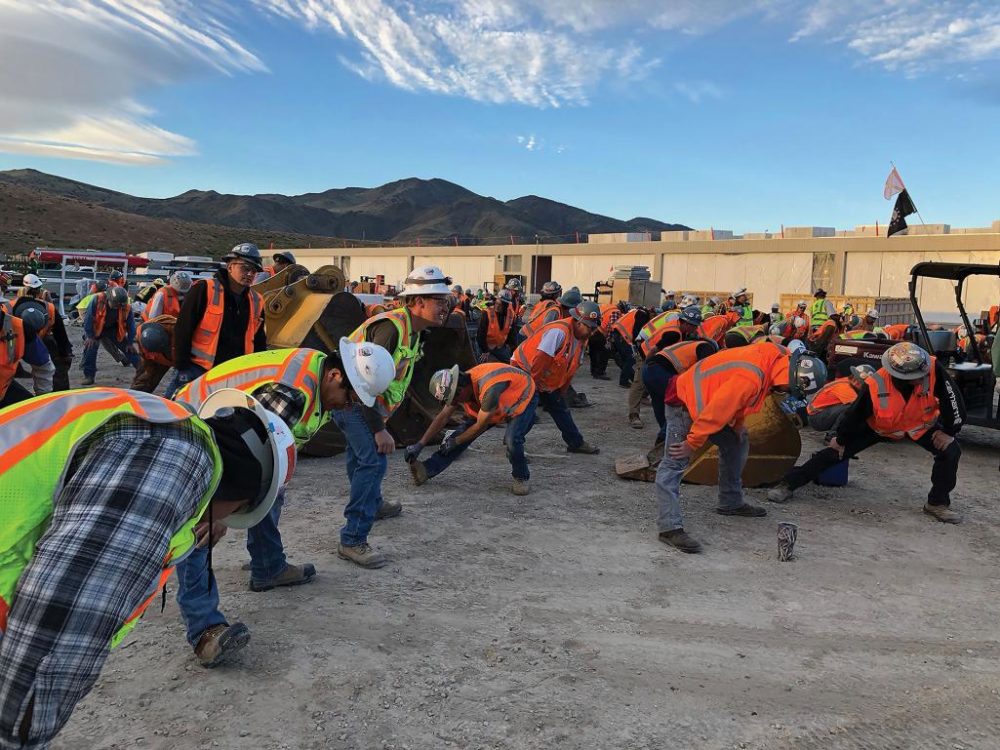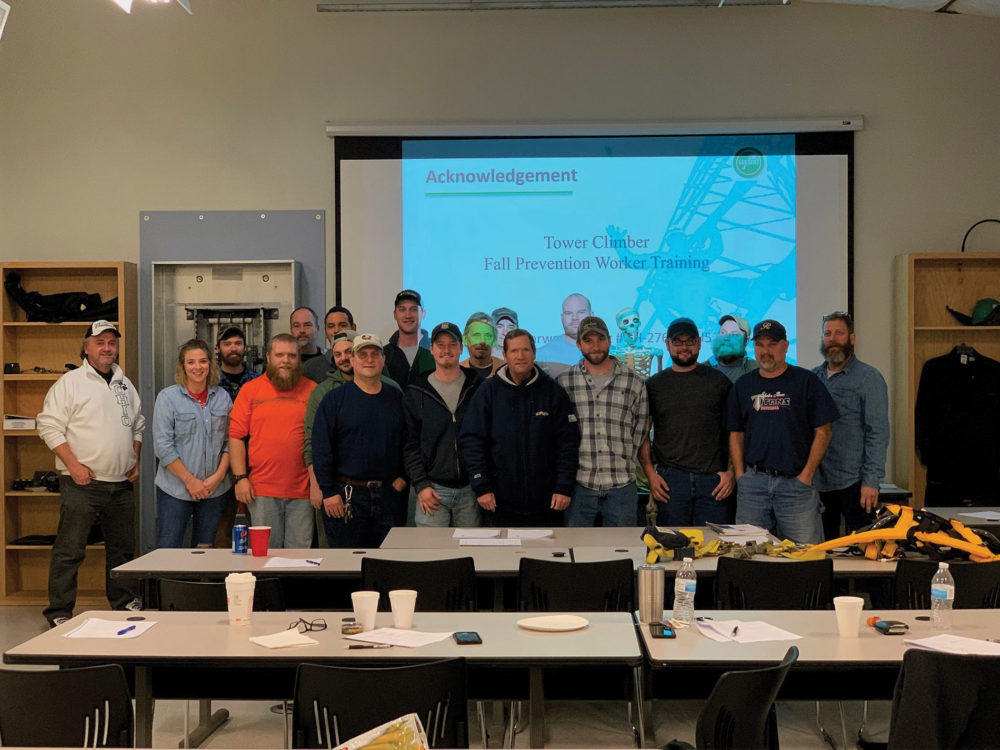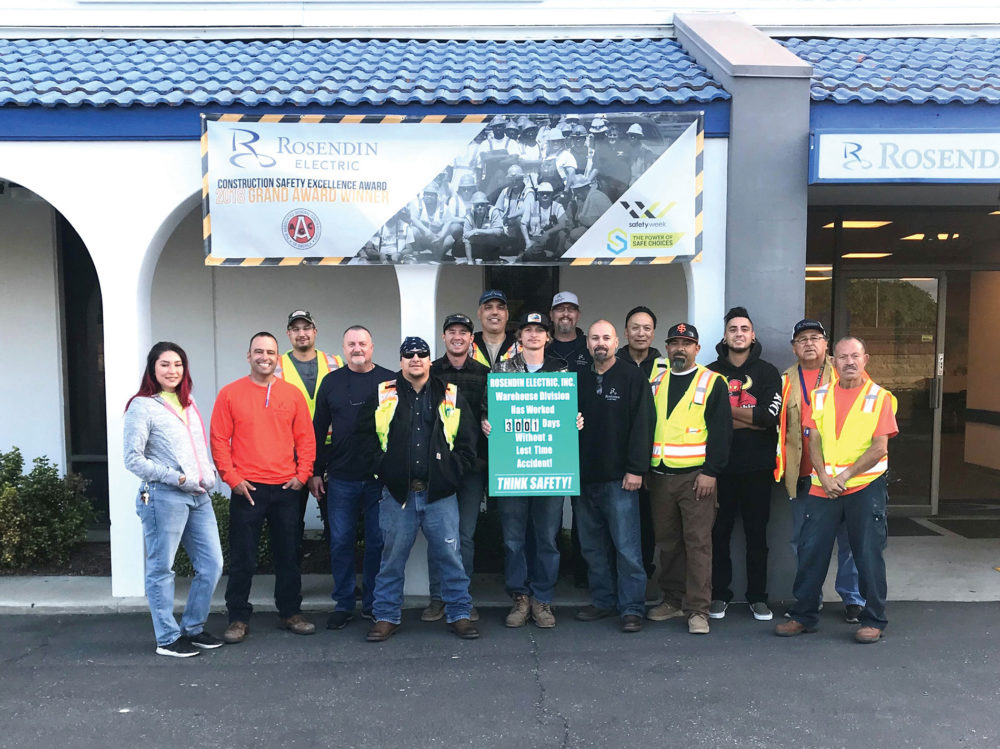If you think there is no cost to skimping on safety, think again. In 2018, the Occupational Safety and Health Administration (OSHA) issued 29,416 citations and $87 million in penalties in the construction industry. Resulting in everything from personal injury and property damage to increased insurance rates, the failure to adhere to safety standards and best practices can cause irrevocable harm to a contracting firm’s livelihood in an already competitive industry. Some contractors are making safety priority number one.

E-J Electric Installation Co.—a culture of safety
“Safety is embedded into everything we do,” said Bill Dayton, corporate safety director at E-J Electric Installation Co., a 120-year-old contracting firm based in New York. “We believe that people are our most important asset and that their safety at the work site is our greatest responsibility.”
E-J Electric has implemented dozens of safety checkpoints in its operations, including daily “stretch and flex” programs for field and administrative personnel, a daily safety message emailed to every employee, mandatory personal protective equipment protocols, safety advisories and a “20/20/20 Situational Awareness” program, which instructs field workers on identifying and reporting potential hazards.
“We also conduct a range of safety seminars and training for all leaders and fleet management/monitoring that includes comprehensive vehicle inspection, GPS tracking, periodic driving record checks, and random drug testing,” Dayton said.
In 2015, the company hired a corporate safety director to revise and strengthen existing safety programs and procedures, develop new safety initiatives, and build the culture companywide. The initiative is supported by a full-time transmission and distribution division safety director, a field safety director, and contract/project-specific site safety managers.
“Since then, our efforts have resulted in a 42 percent reduction in the overall occurrence of incidents, a 60 percent reduction in OSHA-recordable occurrences, and 54 percent fewer lost-time occurrences, and we’ve continued to achieve incremental reductions annually while growing our market share and workforce considerably,” Dayton said.
The company received a 2018 Building Trades Employers Association Construction Safety Award for Overall Project Safety for its work on New York City’s Throgs Neck Bridge renovation and repair.
For other contracting firms interested in implementing a formal safety program, Dayton said industry support is available.
“While there may be setbacks, it’s essential to stay focused on a zero-incident goal,” Dayton said. “No situation is impossible to manage, and other professionals in the safety industry have been there and can help.”

- Employees at Sargent Electric participate in Tower Climber Fall Prevention Worker Training. Photo credit: Sargent Electric
Sargent Electric Co.—setting the bar
“Safety programs are vital, as that’s where the foundation for communication and expectation begins,” said Matthew Babilon, director of health and safety for Sargent Electric Co., a Pittsburgh-based firm founded in 1907. “As an employer, you set the performance bar, and employees will work at that level of expectation; every employee needs to know the standards of behavior that are acceptable and unacceptable.”
Among Sargent’s key safety measures are safety observations performed by all field employees in conjunction with supervisor audits completed by project managers and foremen.
“The goal of rolling out these programs is to engage the field in not only the hunt for hazards but also in correcting the unsafe behavior and/or conditions before they result in an incident,” Babilon said. “In addition, as contractors have a much higher turnover rate than other industries, we’re also developing an electronic onboarding program to complement our face-to-face orientation, which we feel will shorten the learning curve for employees who may not have the benefit of Sargent’s safety regimen.”
According to Babilon, Sargent’s attention to safety—executed through a tiered network of safety specialists, regional safety managers and a safety director who reports to the president/CEO—has yielded big dividends.
“Improving our employee involvement helped us reduce our incident rate by almost half in 2018, which has not only affected safety, but quality and production as well,” he said. “We’ve found that top performers in the programs have a significantly lower total incident rate than those less involved.”
Among his top tips for establishing a successful safety program, Babilon said consistency in program design and expectations are key.
“A solid safety program starts with management commitment, clearly written policies, and an actionable program,” he said. “Training and selection of the proper managers to guide your workers needs to be consistent, fair, and ensure unbiased accountability regardless of client pressures, tight schedules and labor issues.”

- In May 2018, Rosendin’s San Jose, Calif., Warehouse Division was recognized for working 3,001 days without a lost-time incident. Photo credit: Rosendin Electric
Rosendin Electric Inc. – prioritizing safety
Marty Rouse, vice president of safety at century-old, San Jose, Calif.-based Rosendin Electric Inc., is clear on the need for vigilance when it comes to safety.
“The main reason for safety measures is to ensure that you’re protecting your employees from hazards on a project and that they go home each day without being injured,” he said. “Safety is a value that you place before everything else and one which you never want your employees to compromise for any reason.”
While OSHA requires firms to put such safety measures in place to protect employees from hazards, Rouse said it’s in a firm’s best interests to do so anyway.
“If you have an incident on your project where OSHA is involved and you don’t have safety measures or programs in place, there’s a great chance that you’ll receive several thousands of dollars in violation fines—penalties which can also prevent you from being able to be on the bid list for several contractors and/or clients,” he said.
Among the many safety measures Rosendin has instituted, the company has created a Safety Professional Handbook, developed a curriculum for safety-related professional development, and used videos and posters to promote the proper use of power tools and equipment.
“We also prepare formal safety reports, conduct regular inspections, track our progress on a safety dashboard, and sit on the NECA Large Contractors Safety Group as a representative,” Rouse said.
Thanks to the collaborative efforts of Rosendin’s 80 safety professionals, including a vice president of safety, a senior corporate safety director, and both West and East Coast corporate safety directors, “Rosendin concluded 2018 with close to 11 million man-hours and an incident rate of 0.68 with zero lost-time injures,” he said. “We received first place awards for safety in California and at the national Associated General Contractors conference in our category, ultimately receiving AGC’s Grand National Award for Construction Safety Excellence.”
Rouse confirmed a safety-first culture needs to be driven from the top-down.
“Safety is only as good as management allows it to be,” he said. “Without the support of upper management, you won’t be very effective in rolling out a safety program. When everyone is moving in the same direction for safety—top-down and bottom-up—you’re on the path to creating a safety culture.”
Ordes Electric Inc.—a matter of trust
According to Steve Ordes, president of Chalmette, La.-based Ordes Electric Inc., his firm’s 2014 partnership with Smart Safety Group—a provider of safety services, staffing, training and products to help make organizations regulatory-compliant, lower insurance costs and reduce worker’s compensation claims—has resulted in a culture focused on safety and quality.
“A culture of safety takes time to develop and starts with a positive and trusting relationship between all levels of management and our safety director,” Ordes said. “Through positive encouragement, employee empowerment, and a review of lessons learned to reiterate safe work practices, our safety director helps create an atmosphere where all employees can approach our safety team with concerns and know that we’re thankful to be informed of any issue.”
He said the safety team is comprised of all project managers and meets monthly to discuss current work, trends and upcoming job sites.
With slip/trip/fall and electrical work standing as the leading cause of injuries, “our commitment to safety starts by understanding the ever-changing job site and surrounding environment every day and focusing on basic safety first, especially housekeeping and site setup/layout,” he said.
To reinforce safety messages, Ordes Electric has instituted a “watch your step” protocol, whereby workers find a different path if they can’t see where they’re going to place their next step. The company also has instituted the “six-foot circle” approach, which encourages workers to ensure at least a 6-foot radius around them is clear of debris, tools or materials.
“These programs work, as reflected by only one slip/trip/fall case here in the last five years,” Ordes said. “Safety is nonnegotiable, and proper preplanning and safe work practices should be developed by your team prior to the start of any job. Develop a safety team under the leadership of a qualified safety manager or management company, hold weekly safety toolbox talks and monthly safety meetings, and conduct continuous safety training. Simple measures like these will lower a company’s risk by promoting a positive safety culture that includes all associates.”
Eye on Ergonomics
While poor ergonomics practices don’t necessarily result in safety violations, “injuries caused over time by repetitive tasks, excessive force, localized pressure, vibration and sustained or awkward postures can adversely affect productivity even before symptoms are detected, as workers gradually lose strength and endurance,” said Jacob Thomas, ergonomics specialist at Greenlee Tools.
“Over the course of months, accumulated muscular damage and inflammation can result in painful conditions such as carpal tunnel, tendonitis, epicondylitis (commonly known as tennis/golf elbow), and more and can also create legal hassles.” While the medical cost of injuries may not directly impact contractors, as their insurance or workers compensation may absorb the cost, “contractors will be affected by rate increases, as their recordable incidence rate and experience modification rate will rise, affecting their ability to win bids,” he said.
Ergonomic design focuses on preventing workers from pushing their bodies to the extreme. According to Thomas, well-designed tools avoid excessive reach, poor posture, wasted movements and excessive force or muscle effort to perform jobs while promoting intuitiveness, ease of use and balance.
Thomas recommends ECs approach better ergonomics by first evaluating their environment. He suggests asking questions about the jobs employees perform, how often and for how long they work, as well as questions such as, “Does the environment force the worker to assume bad posture?” or more plainly “Are employees working in enclosed spaces, are obstructions causing awkward reaches, etc.?”
Then he advises employers to ask workers if any jobs are uncomfortable to perform or cause physical pain. Finally, investigate and record the number and types of injuries or strains in your work history, and determine jobs that are in the common denominator.
When evaluating equipment, Thomas said, “Put the tool in the worker’s hand, have a tool representative demonstrate its proper use, and then have the worker report back on it after a week. While not necessarily the most scientific approach, it still delivers the best results.”
“Only after you understand the requirements of the job, the tasks that are difficult for your employees to perform, and the kinds of injuries these jobs are causing can you accurately select tools and equipment to best address it,” Thomas said
By Susan Bloom
https://www.ecmag.com/section/safety/safe-bet-contractors-nationwide-discuss-safety-measures-their-firms-cant-function
